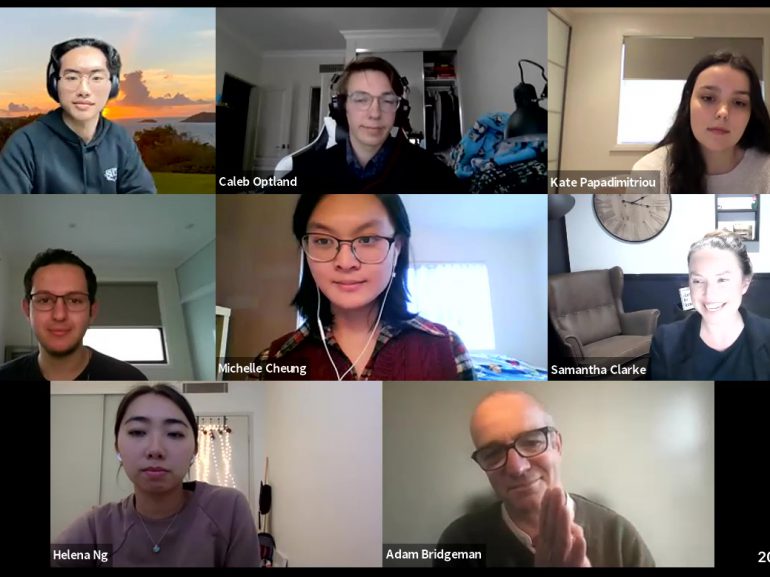A few weeks ago during the 2021 Sydney Teaching Symposium, students from a range of faculties, backgrounds, and year levels spoke about their own experiences of learning on and off campus over the past 18 months. From their candid and thoughtful responses to burning questions posed by staff, we’ve curated the top 10 student insights here.
This article was contributed by members of the student panel (Mahmoud Al Rifai, Kate Papadimitriou, Michelle Cheung, Robert Tran, Helena Ng, Caleb Op’T Land), Rebecca Denham and Samantha Clarke.
Insight 1: Build student-teacher and student-student relationships
I had one tutorial where the tutor made a point of remembering my name – it really made me look forward to going that tute…
A key theme of the symposium was building and maintaining relationships in education, with our keynote speaker Peter Felten inviting everyone to “consider putting teacher-student and student-student relationships at the heart of your teaching“. Our student panel gave us a clear message that connecting with their teachers and peers made all the difference. They mentioned a few simple things that teachers had done to make them feel they had a personal connection with their teachers at a time when they may be feeling more isolated – things like having regular zoom drop-ins, using students’ names, checking on their wellbeing as well as their study, and providing regular updates via emails or announcements with important dates and reminders.
Weekly drop-ins, whether on zoom or face to face – even just being able to go to them and have a chat with your teacher, it’s really invaluable to forming a relationship…
Fostering relationships between students is just as important, with one panellist describing a valuable time where he formed lasting connections with peers by participating in extended activities before the unit started, with a dedicated group: “It was really helpful, you have a dedicated group, you know who your friends are, you have a base that you can expand out of in the unit“. Another idea for building relationships was for the whole class to work together on a project, like a class charter, or a Canvas page that everyone contributes to, creating a feeling of connection in the class.
Insight 2: Students appreciate flexibility and choice of mode
The student panel was asked about the factors that influenced their choice of whether to attend classes in-person or participate remotely. Students’ responses were that they appreciated the flexibility of being able to choose and, in this choice, there were two key factors that influenced their decision:
- whether it was practical to come in the campus (often this is around timetables and distance – students travelling a long way are reluctant to attend for a single class), and
- the benefit they saw in in-person classes, such as when it involved getting more interaction or better access to demonstrations.
[My decision is based on] whether or not I’ll get more out of an in-person class than I would just doing it at home… in some of my tutorials on Zoom, I wasn’t talking to anyone, I was just doing the worksheet by myself…
Students also talked about the need for a balance between face to face and online – for example, one student decided on face to face for labs and tutorials, given the lectures were all online: “it’s really important to get one on one or group interaction in your classes“
Insight 3: Provide safe environments for contributions
As our teaching will likely continue to involve Zoom classes, staff were keen to get a feel from the panel about how to make their Zoom tutorials a space where students feel safe to contribute and learn, and also how teachers can measure engagement when students may not have their cameras on. The two key takeaways were that students feel more comfortable contributing in smaller groups and that there are easy ways to check for engagement and understanding without needing cameras on.
My ideal zoom tutorial would have a lot of work in breakout rooms – it’s the closest you can get to a face-to-face class. Because you’re working in such small groups with your peers, not only do you feel more safe to contribute, it also gives you chance for a little bit of social contact.
To check for understanding and to measure engagement without putting students on the spot, the panel appreciated teaching techniques such as the use of anonymous polls, asking students to use the reactions available in Zoom, or just getting them to put their responses in the Zoom chat. “Teachers get those students who have their cameras turned off to just do a little reaction, like a thumbs up just so they know they’re engaging…people [also] use the chat function to say something they want to contribute.“
One of the panellists identified the benefit of clearer structure in their tutorials, where students know that once they have attempted the problem, the tutor will go over it, rather than students having to ask. Another panellist mentioned how connecting the content to the real world made those classes feel more relevant and engaging. “The tutorials that I really enjoy are where then the tutor spends the first 5 minutes linking it to real-life concepts… how what we’re going to learn applies to the real world and our careers…”
Insight 4: Provide options for assessing engagement and participation
Touching on measuring engagement, the panel was asked how teachers can assess participation in ways that are fair and helpful for learning. Whist having a range of experiences in this area, the panellists agreed that it was fairer to have options of how students could demonstrate participation, rather than just turning up and speaking in class. For example, a system where students could choose to be marked for live participation or have an optional task to do before the class instead of verbally contributing in the class. They went on to say that they also found it more meaningful and less stressful if participation was not assessed every week for every student.
That’s fair, because you’re not disadvantaged [if you’re an introvert], you’re still engaging with the content.
One panellist recognised that having marks for participation was linked with showing up to class and that discussing class content did encourage discussion but warned against tricks like having participation marks assigned to a quiz given only at a specific time in the lecture, which makes students feel that “they’re backed into a corner… felt like you were forced to be there rather than wanting to share your opinions.“
Insight 5: Make things easy to find on Canvas
The panel also had some clear advice on removing barriers to learning by having well-designed Canvas sites. The focus here is on clarity and organisation – making it easy to find resources through labelling and structure, and having frequently asked questions. Aside from helping students, one of the benefits is that it reduces the need for students to ask the lecturer how to find things, freeing up more time to communicate with our students on the actual course content. “When the layout is very clear it means that learning is super easy and you don’t have to communicate with tutors so much because all the content was there, and there were frequently asked questions that were constantly being updated.” For another panellist, having resources well labelled and organised in a consistent way made it much less overwhelming to join a unit a bit later in the semester.
Insight 6: Design assessments that are authentic and encourage deeper thinking
Panellists were asked about assessments that they found meaningful and helpful. The responses were varied around assessment type but all responses shared common themes of requiring depth of thinking, application to the real world, or authentic experiences – assessments that gave them an opportunity to experience activities typical of their field of study and that helped them to develop their critical thinking skills. For one of our panellists, the most meaningful assessment was an essay, which are often seen as being less authentic or relevant, although this essay was on a topic where many people have strong opinions:
…[it] forced me to research and really learn about and evaluate all sides of the discussion and understand where these different viewpoints had come from and it really made me re-evaluate my own beliefs and my own values – it wasn’t just like I was doing an assessment for uni, it was like I was really learning and developing as a person as well.
Interestingly, for another student, helpful and meaningful were different things! The most helpful assignments were evaluation assignments – similar to what “professionals do in a workplace“ and marked to professional standards. But meaningful assignments were those that “required you to think and challenge yourself and engage in philosophy and multi-disciplinary areas”. Similarly, a first-year student described how a group assignment on a problem was really meaningful and helpful as it gave “hands-on experience on what it means to be an engineer…something that gives [a] first-year an experience of what they’ll be doing with their degree”. In subjects like law, one panellist found a lot of meaning in an assignment that involved going to court and writing a report: “it was eye-opening… it gives a real-life aspect of the law… something you couldn’t imagine just be reading your textbook“.
Insight 7: Focus on organisation and communication for group work, especially when online
On group work, the panel had some useful insights for how teachers can make this run more smoothly. It was noted that group work can be really great or an absolute disaster – especially when online – but the common thing for successful group work is are two key ingredients: good organisation and effective communication.
…the students all have the same understanding of what needs to be accomplished, and what steps need to be taken. It’s important to have group communication – and to set individual tasks or roles, perhaps have a group leader.
On communication, one panellist mentioned that while many groups rely on social media channels to communicate, it can be really useful when teachers provide some direction: “…one of my units did a really good job of making sure that everybody contributed by creating a Canvas discussion group. Having some common ground between teachers and students is quite important [as it] can give peer to peer support and teacher to peer support…“
Another panellist noted the benefits of working in the same groups over a period of time: “..we all love working with people that we have worked with before – we know how they work, what their timelines are, how we can accommodate to each other’s strengths”. However, it was also noted that there was often a lot of stress associated with choosing their own group, especially for students who don’t know anyone else in the class; “…when they announced the group work I was like, oh no, I hate forming groups, it’s nerve-wracking…“. This student really appreciated the way the groups were formed by his teacher: there was a poll on interests around the topics, and then the teachers put the students into groups with similar interests “… I ended up being in a really good group – I got to know some new people, but not feel the pressure of having to find it.“
Insight 8: Use open book exams
Students identified closed book exams as being susceptible to academic integrity issues, one reason being that students struggle to memorise the content in time and so are more tempted to cheat. They recommended replacing them with open book exams which, rather than relying on rote memorization, rely on an understanding of the concepts, making exams more difficult to cheat on but also better at assessing knowledge and understanding of content; “[the] shift to online has made it easier to cheat, but to guide students away [from this pathway], make exams open book where possible …[exams that] really require you to think, [where] you can’t just type it into Google“.
Insight 9: Show compassion and be flexible
The question “What do you wish your teachers knew about what it’s like to be a student at the moment?” gave our panellists the opportunity to show us how important it is to recognise the complexity of all our lives. The students recognised that teaching under the current circumstances has meant a lot of changes and extra effort but wanted to remind us that students are also having to deal with multiple demands on their time and facing other life challenges that are impacting their studies, and things like showing understanding, connecting with compassion, and being flexible can make a real difference.
… it’s really difficult for [teachers] to have to change up their whole teaching style, things are already hard enough for them online, but it’s a struggle for us too, and although we are in their class, we have a bunch of other classes happening in the background, and work and family stuff, and COVID… things are hard for everyone.
Insight 10: Prioritise mental health, flexibility, and connections
Finally, recognising that the challenges we’ve been facing have also resulted in innovation and improvement in the way we teach and learn – the panel gave us an idea of what we should hold onto post-COVID, with the top choices being open book exams, drop-in sessions on Zoom, flexibility and ensuring mental health is prioritised, and simple extensions.
A final message from one panellist:
…now we’re all doing this distance learning thing, right now it’s the most important time to show the connection with your students…
Want to know more?
- To watch a recording of the student panel in full, access the 2021 Sydney Teaching Symposium resources page (the password is ‘relationships’). You can also check out the recordings and resources compiled from the rest of the symposium.
- Visit the COVID teaching support Canvas site for an overview of resources to support teaching off-campus.






2 Comments